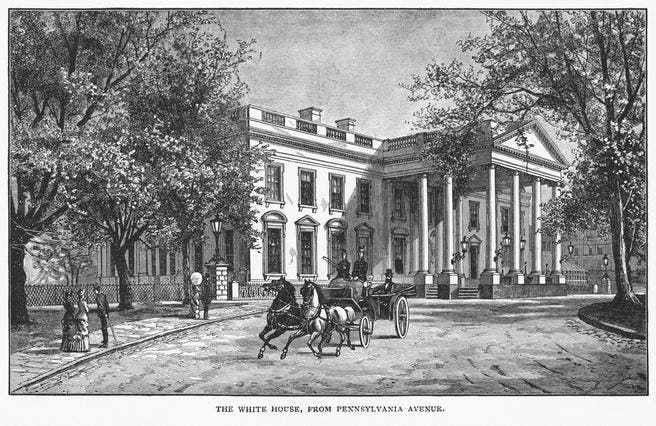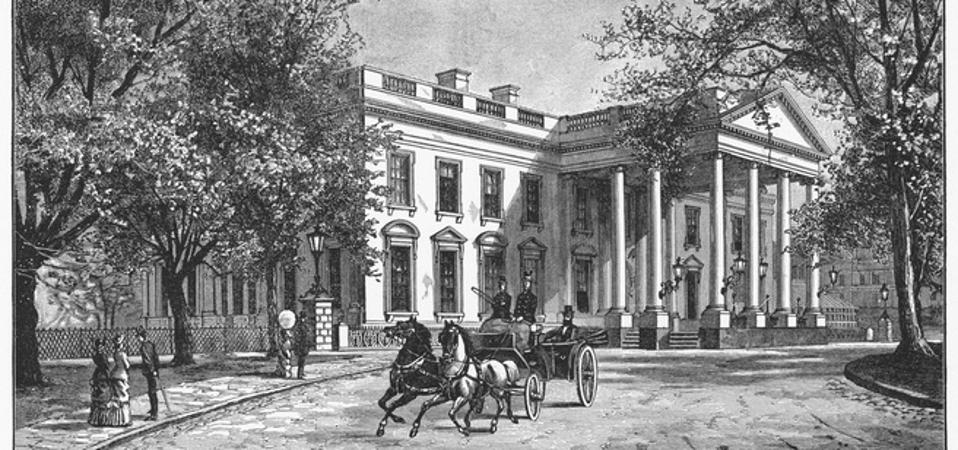A lot of U.S. presidents have kept pets at the White House, and most have been well-behaved. Here’s the story of one that wasn’t.
getty
The White House has hosted a surprising menagerie over the centuries — dogs, cats, birds, snakes, ponies, raccoons, even hippos have made occasional appearances. Many of these animals were benign companions, beloved both by presidents and by the public.
The quiet, dignified dog lying at the foot of a president’s desk, such as Fala (Franklin Roosevelt’s Scottie) or Liberty (Gerald Ford’s golden retriever), tends to dominate popular imagination.
Yet, one canine stands out in the historical record for his aggression: Pete, the dog of President Theodore Roosevelt. One telling incident reportedly involved Pete tearing the trousers of the French ambassador, Jean Jules Jusserand, during a White House visit. That dramatic moment, over a century ago, wasn’t a lone incident. Here’s the story of arguably the White House’s most aggressive pet.
Pete-Gate
The most famous anecdote about Pete centers on a diplomatic embarrassment. According to multiple sources, during a reception at the White House, Pete chased Ambassador Jean Jules Jusserand across the lawn (or through a corridor), caught up to him and ripped the seat or leg of his trousers. The ambassador reportedly climbed a low tree limb to escape further harassment.
Though newspapers and later historians sometimes embellish, congressional or official protests reportedly followed. After that incident, Pete’s presence at diplomatic gatherings became too risky.
But this wasn’t his only misdeed. Contemporary accounts detail multiple biting and chasing episodes:
- He reportedly bit policemen and naval officers
- He reportedly chased James Rudolph Garfield, Secretary of the Interior, tearing his trousers in one episode
- He is said to have chased George B. Cortelyou, who escaped by climbing a tree
- On at least one occasion, he engaged in fights with stray dogs entering the White House grounds, suffering serious injuries
Because of these incidents, President Roosevelt eventually had Pete removed from the White House. Pete died in October 1910.
What Kind Of Dog Was Pete? Breed, Behavior And Biology
To learn more about why Pete may have displayed aggressive behavior, it might be helpful to take a closer look at his breed. Historical sources differ, with some calling him a bull terrier, and others describing him as a Boston bull terrier or even vaguely as a “bulldog.”
In The Pawprints of History, Stanley Coren describes Pete as a “fighting bulldog,” though noting the classification is ambiguous.
If Pete was a bull terrier or close to that lineage, some behavioral traits become relevant from a biological standpoint. Bull terriers and their related breeds are known for strong musculature, high energy, tenacious temperament, and, in poorly socialized individuals, potential for dog aggression (especially if challenged or stressed).
These dogs were historically bred for tasks such as ratting, guard work and sometimes dog-fighting in some locales. Their bite force and willingness to persist in an attack are greater than many breeds that are less robust.
However, a dog’s breed is never entirely deterministic. Individual variation, early socialization, training and environment play huge roles. A well-bred bull terrier with a sound temperament can be gentle and companionable.
Pete’s behavior suggests that he perhaps lacked consistent training, was under stress from the buzzing politics and crowds of Washington and may have tolerated or even cultivated aggressive reactions.
From a biological risk perspective, Pete was a medium-to-large dog with combat-capable jaws and a propensity to chase. His behavior would be unpredictable in crowded environments. From the ambassador incident alone, one can infer he had sufficient jaw strength, persistence and bite control to inflict damage on a human fabric barrier (i.e. trousers), which implies nontrivial power.
In modern canine behavioral science, one would examine Pete’s threshold for provocation, his stress response curve (fight/flight tipping point) and his bite inhibition (or lack thereof). The many documented incidents suggest his bite inhibition was poor, as he did not reliably stop short of wounding or tearing fabric.
Other White House Animals: Pete Was Scary, But Not The Scariest
Though Pete’s misadventures stand out, he probably was not the most inherently intimidating animal ever kept at 1600 Pennsylvania Avenue. The pant-ripping is dramatic, but many White House pets have been biologically exotic and potentially dangerous.
- John Quincy Adams was famously rumoured to have kept an alligator, possibly even in the East Room bathtub.
- Calvin Coolidge accepted exotic gifts: a pygmy hippopotamus named Billy was sent from Liberia, weighing some 600 lb and measuring about 6 ft long. He also had raccoons (Rebecca), a black bear, lion cubs and other more exotic creatures.
- The White House Historical Association lists other unusual animals: a macaw, sheep (used to graze the lawns during Wilson’s presidency) and livestock like a cow (Pauline Wayne) among them.
In broader context, Pete’s episode is one among many in the fascinating annals of presidential pets.
Are you an animal lover who owns a pet? Take the science-backed Pet Personality Test to know how well you know your little friend.









